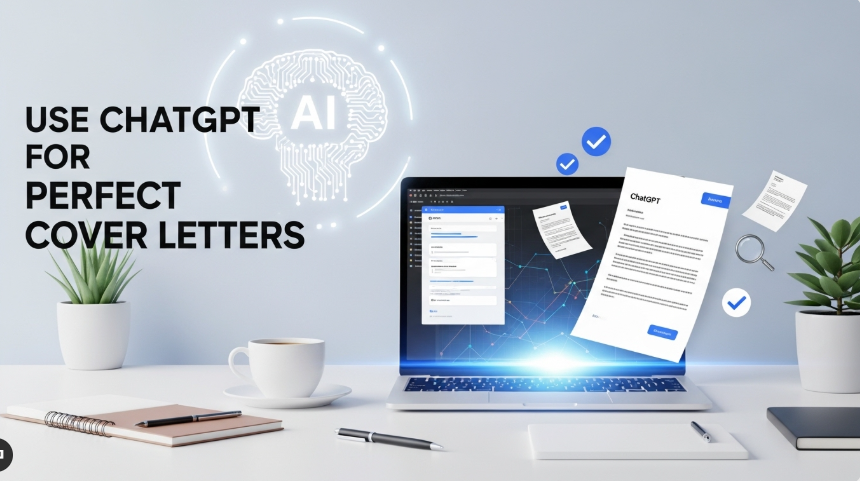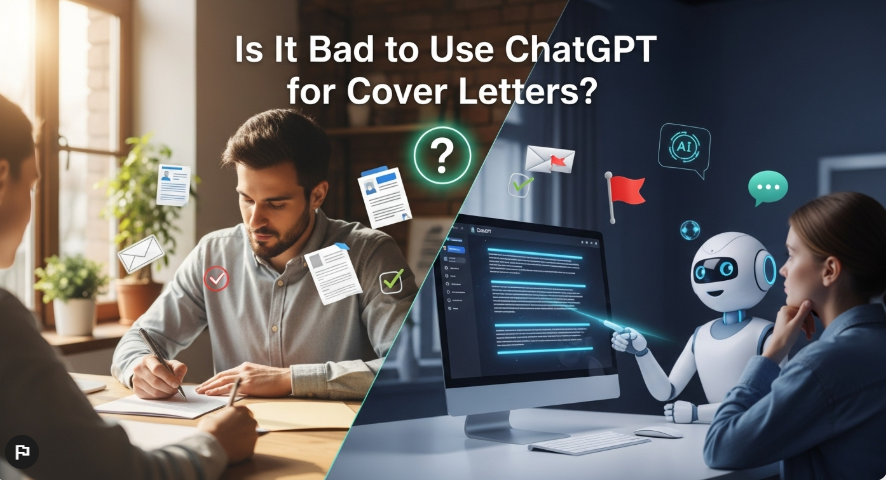In today’s competitive job market, a well-crafted cover letter can set you apart from other candidates. It’s your chance to introduce yourself, highlight your skills, and show why you’re the perfect fit for a job. But writing a cover letter can be time-consuming and challenging, especially if you’re applying to multiple positions. This is where ChatGPT, an AI-powered tool developed by OpenAI, comes in. It can generate text quickly based on your prompts, making it a popular choice for drafting cover letters. But is it a good idea to use ChatGPT for this purpose?
A cover letter is often the first impression a recruiter or hiring manager has of you. It should be professional, persuasive, and tailored to the job. However, not everyone is a confident writer, and crafting a unique letter for each application can feel overwhelming. ChatGPT, launched in 2022, is an AI tool that can generate human-like text based on vast datasets. it’s widely used for tasks like writing cover letters. But is it bad to rely on ChatGPT for this? Let’s break it down by looking at the benefits, drawbacks, best practices, and employer perspectives.
Pros of Using ChatGPT for Cover Letters
Using ChatGPT to draft cover letters offers several advantages, especially for busy job seekers. Here are the key benefits:
- Time Efficiency: ChatGPT can produce a draft in seconds, saving hours compared to writing from scratch. This is ideal when applying to multiple jobs.
- Consistent Storytelling: It creates a cohesive narrative that aligns your resume with the job requirements, ensuring a professional tone.
- Tailored Customization: By inputting the job description, ChatGPT can generate a letter that matches the role’s specific needs and keywords.
- Invaluable Insights: It can suggest ways to highlight skills or experiences you might not have thought to include, helping you present your best self.
These benefits make ChatGPT a valuable tool for overcoming writer’s block or managing high-volume applications.
Cons of Using ChatGPT for Cover Letters
Despite its advantages, ChatGPT has limitations that could affect your application. Here are the main drawbacks:
- Generic Content: ChatGPT often produces letters that sound broad or formulaic, which may not impress hiring managers looking for unique applications.
- Lack of Specific Examples: It might not include quantifiable achievements, like “increased team productivity by 15%,” which are crucial for standing out.
- Potential Inaccuracies: Without clear prompts, ChatGPT may include incorrect or irrelevant details, such as skills you don’t have.
- Detection Concerns: Some employers might recognize AI-generated text, especially if it lacks personal flair or sounds overly formal. This could raise questions about your effort or authenticity.
These cons highlight the importance of using ChatGPT as a starting point rather than a final product.
Learn more about Can chatgpt create Notion Templete?
How to Use ChatGPT Effectively for Cover Letters

To make the most of ChatGPT, follow these steps to create a polished, personalized cover letter:
- Visit ChatGPT: Go to chat.openai.com and log in or create a free account.
- Prepare Your Information: Gather your resume, the job description, and details about the company’s culture or values.
- Craft a Specific Prompt: Use a clear prompt to guide ChatGPT. For example:
- “Write a cover letter for the [Job Title] position at [Company Name]. Here is my resume: [paste resume]. Here is the job description: [paste job description]. Highlight my relevant skills and experiences.”
- Generate the Draft: Let ChatGPT create the initial cover letter based on your input.
- Review and Edit: Check for accuracy, add personal details, and ensure the tone reflects your voice. Include specific achievements, like “managed a team of 10” or “reduced costs by 12%.”
- Customize Further: Ask ChatGPT to tweak specific parts if needed. For example:
- “Make this paragraph more enthusiastic.”
- “Add details about my experience with [specific skill].”
- Final Proofread: Read the letter carefully to catch any errors or inconsistencies before submitting.
Best Practices for Using ChatGPT
To ensure your cover letter is effective, keep these tips in mind:
- Use Specific Prompts: The more details you provide, the better the output. Include your resume and job description for tailored results.
- Always Edit: Never submit an AI-generated letter without personalizing it. Add your unique experiences and voice.
- Include Quantifiable Achievements: Highlight specific results, like “increased sales by 20%,” to make your letter stand out.
- Tailor to Each Job: Customize the letter for every application, even if the roles are similar, to show genuine interest.
Example Prompts for ChatGPT
Here are some effective prompts to try:
- “Write a professional cover letter for a [Job Title] position at [Company Name] using my resume: [paste resume].”
- “Create a cover letter that highlights my experience in [specific skill or industry] for the [Job Title] role.”
- “Draft a cover letter that emphasizes my passion for [company’s mission or values] and how my skills align with the [Job Title] position.”
- “Write a concise cover letter (under 300 words) for a [Job Title] role, focusing on my achievements in [specific area].”
These prompts help ChatGPT generate targeted, relevant content.
| Step | Action | Details |
|---|---|---|
| 1 | Visit ChatGPT | Go to chat.openai.com and log in or sign up. |
| 2 | Prepare Information | Collect your resume, job description, and company details. |
| 3 | Craft Prompt | Use a specific prompt with resume and job description for tailored output. |
| 4 | Generate Draft | Let ChatGPT create the initial cover letter. |
| 5 | Review and Edit | Add personal details, check accuracy, and include specific achievements. |
| 6 | Customize Further | Ask ChatGPT to tweak tone or add specific details if needed. |
| 7 | Final Proofread | Check for errors and ensure the letter reflects your voice. |
Employers’ Views on AI-Written Cover Letters

Employers have varied opinions on AI-written cover letters, reflecting the ongoing debate about AI in job applications:
- Positive Perspectives: Many recruiters understand that writing cover letters is time-consuming. They may not mind AI use if the letter is professional, relevant, and tailored to the job. Some even appreciate candidates using all available tools to present themselves well.
- Concerns About Authenticity: Other employers worry that AI-generated letters lack personal effort or authenticity. If the letter sounds too generic or doesn’t match your resume, it could raise red flags. In academic settings, for example, some hiring committees view AI use negatively, as it might suggest a reliance on AI for other professional tasks.
To address these concerns:
- Personalize Thoroughly: Include specific details, like projects or experiences, that only you know.
- Match Your Style: Ensure the tone aligns with your communication style, as seen in your resume or interview.
- Be Transparent (If Asked): If questioned, admit to using AI as a tool but emphasize that you edited and personalized the letter.
A 2023 study from Jobscan found that applicants with cover letters were 3.4 times more likely to land interviews, suggesting that a well-crafted letter—AI-assisted or not—can make a difference (Jobscan).
Ethical Considerations
Using ChatGPT for cover letters is generally not considered cheating, as it’s similar to using a template or getting help from a friend. However, ethical concerns arise if you submit an unedited AI-generated letter that misrepresents your skills or lacks authenticity. The goal is to use ChatGPT as a tool to enhance your application, not to replace your effort. Always ensure the final letter accurately reflects your qualifications and enthusiasm.
Can Employers Detect AI-Written Cover Letters?
Some employers might detect AI-generated text if the letter:
- Sounds overly formal or generic.
- Uses unusual phrasing or structure.
- Doesn’t align with your resume or personal style.
However, thorough editing and personalization can minimize this risk. Tools like CoverLetterGPT.xyz claim to produce letters that pass AI detection, but the best approach is to make the letter your own. Adding specific examples and tailoring the tone to your voice reduces the chance of detection.
How to Make Your Cover Letter Stand Out
To create a standout cover letter with ChatGPT:
- Include Specific Examples: Highlight achievements like “led a team of 10 to complete a project ahead of schedule” or “increased customer retention by 15%.”
- Tailor to the Job: Use the job description to align your skills with the role’s requirements.
- Show Genuine Interest: Express enthusiasm for the company’s mission or values.
- Reflect Your Personality: Edit the letter to sound like you, not a machine.
A personalized, specific cover letter is more likely to catch a hiring manager’s attention.
Conclusion
Using ChatGPT for cover letters can be a smart move if done thoughtfully. It saves time, helps overcome writer’s block, and can produce a solid starting point. However, it’s crucial to personalize and edit the output to ensure it’s accurate, unique, and reflective of your voice. Employers may have mixed views, but a well-crafted, tailored letter—AI-assisted or not—can boost your chances of landing an interview. By following best practices and focusing on authenticity, you can use ChatGPT to create a cover letter that showcases your skills and enthusiasm effectively.
Frequently Asked Questions (FAQs)
Q: Is it bad to use ChatGPT for cover letters?
A: It’s not bad if used as a tool. ChatGPT can help draft letters quickly, but you must edit and personalize the output to make it authentic and relevant.
Q: Can employers tell if a cover letter is written by ChatGPT?
A: Some might notice if the letter is too generic or doesn’t match your style. Personalizing it with specific examples and your voice reduces this risk.
Q: How can I make my cover letter stand out when using ChatGPT?
A: Include quantifiable achievements, tailor the letter to the job description, show enthusiasm for the role, and ensure it reflects your personality.
Q: What are some good prompts to use with ChatGPT for cover letters?
A: Try these:
- “Write a cover letter for the [Job Title] position at [Company Name] using the following job description: [paste job description]. Here is my resume: [paste resume].”
- “Create a cover letter that highlights my experience in [specific skill or industry] for the [Job Title] role.”
- “Draft a cover letter that emphasizes my passion for [company’s mission or values] and how my skills align with the [Job Title] position.”
- “Write a concise cover letter (under 300 words) for a [Job Title] role, focusing on my achievements in [specific area].”
Related Articles:
